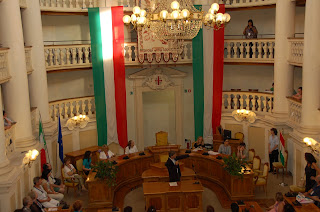



 Part of the internationality day provided an opportunity for us to share work from BHCP with our fellow workshop participants. Not knowing what kind of format or space would be available until that day, prior to leaving for Reggio we copied reflections, pictures, art work and other forms of documentation and brought it all with us. It turned out that a limited number of tables were set up and that we could use some of their display areas for our contributions. We could not take the entire space over with our wares, so we chose to feature the Green class’s bird project and the Blue class’s philosophy night story making from this year to show others the ways we work with both children and their families. Here is what we heard:
Part of the internationality day provided an opportunity for us to share work from BHCP with our fellow workshop participants. Not knowing what kind of format or space would be available until that day, prior to leaving for Reggio we copied reflections, pictures, art work and other forms of documentation and brought it all with us. It turned out that a limited number of tables were set up and that we could use some of their display areas for our contributions. We could not take the entire space over with our wares, so we chose to feature the Green class’s bird project and the Blue class’s philosophy night story making from this year to show others the ways we work with both children and their families. Here is what we heard:“The parent story is a great way to explain your thinking about the very difficult task of collaboration without standing in front and talking. It makes evident the challenges we offer children everyday – we ask them to do things beyond their comfort zones and take risks (the only way to learn). But we, as adults, are not often challenged that way. If something is too difficult for us, we don’t choose to do it (or we hire someone to do it for us!). Thank you for sharing this fabulous idea.” –Debbie from New York City
“I love the connection and continuity you achieved when the Green class invited the younger students to take over this much cherished task. The instruction manual? Wow!” –Josefina, Mexico City
“The ‘take home’ lesson for me was the importance and benefit of the parents being able to experience the same type of learning process that their children experience. Putting themselves in that position would, hopefully, make them more supportive of the teachers and build community among parents as they have the chance to brainstorm and work together. Very inspiring! Thank you.” –Karen from Winston-Salem
As we visited the other participant’s work, we were moved by the images of children from different nations learning in the ways we also value. We are including pictures here from Korea, India, Australia and New Zealand.





We also realize the impact that internationality has had on our experience here, as we unpack the sessions with our new friends from all over the world. Our capacity for understanding has grown because we hear how children are approached in many different countries and we also learn how the other participants will approach children after being in Reggio Emilia. We are including a picture of Lani from Minnesota, Elisabeth and Emelie from Sweden, and Man-Wing from Vancouver to highlight our special relationship with them. BHCP is now a member of a much larger community of learners.
Friends, friends
Ett, tva, tre
All my friends are here with me!
--Swedish version
Ett, tva, tre
All my friends are here with me!
--Swedish version




































